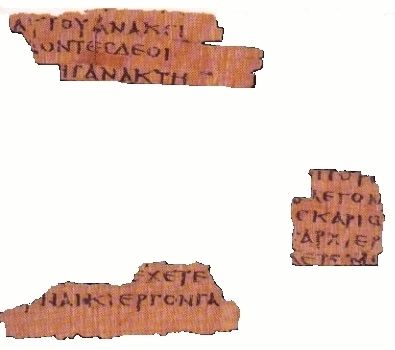Date Late 2nd/3rd century Found Coptos, Egypt | ||
 | ||
Sign P {displaystyle {mathfrak {P}}} Now at | ||
The "Magdalen" papyrus was purchased in Luxor, Egypt in 1901 by Reverend Charles Bousfield Huleatt (1863–1908), who identified the Greek fragments as portions of the Gospel of Matthew (Chapter 26:23 and 31) and presented them to Magdalen College, Oxford, where they are cataloged as P. Magdalen Greek 17 (Gregory-Aland
Contents
The fragments are written on both sides, indicating they came from a codex rather than a scroll. More fragments, published in 1956 by Ramon Roca-Puig, cataloged as P. Barc. Inv. 1 (Gregory-Aland
Date
But in late 1994, considerable publicity surrounded Carsten Peter Thiede's redating of the Magdalen papyrus to the middle of the 1st century (37 to 70 A.D.), optimistically interpreted by journalists. His official article appeared in Zeitschrift für Papyrologie und Epigraphik the following year. The text for the layman was cowritten with Matthew d'Ancona and presented as The Jesus Papyrus, Weidenfeld & Nicolson, London, 1996. (also published as: Eyewitness to Jesus, 1996, New York: Doubleday). Thiede's re-dating has generally been viewed with skepticism by established Biblical scholars. (For example, Peter M. Head in Tyndale Bulletin 46, 1995.)
Philip Comfort and David Barret in their book Text of the Earliest NT Greek Manuscripts argue for a more general date of 150–175 for the manuscript, and also for
Comfort and Barret "tend to claim an earlier date for many manuscripts included in their volume than might be allowed by other palaeographers." The Novum Testamentum Graece, a standard reference for the Greek witnesses, lists
